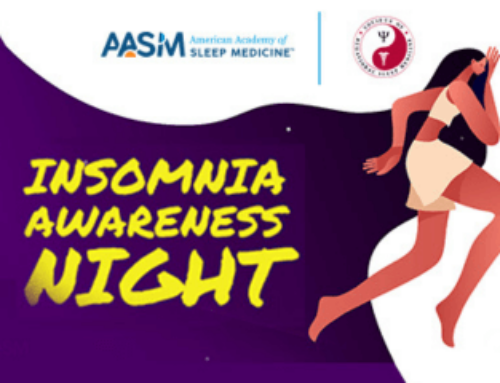EMBARGOED FOR RELEASE: 12:01 a.m., Feb. 15, 2010
WESTCHESTER, IL – A study in the Feb. 15 issue of the Journal of Clinical Sleep Medicine shows that patients with severe obstructive sleep apnea (OSA) report a significantly lower frequency of nightmares than patients with mild or no sleep apnea, indicating that OSA suppresses the cognitive experience of nightmare recall.
Results show that the percent of participants with frequent nightmare recall decreased linearly as sleep apnea severity increased. Frequent nightmare recall, occurring at least weekly, was reported by 71.4 percent of people who did not have OSA and 43.2 percent of patients with mild OSA, which was defined as an apnea-hypopnea index (AHI) of five to less than 15 breathing pauses per hour of sleep. The rate of frequent nightmare recall decreased to 29.9 percent in patients with moderate OSA (AHI of 15 to less than 30) and 20.6 percent in patients with severe OSA (AHI of 30 or more). Sleep apnea severity in people who reported infrequent nightmare recall (mean AHI of 40.3) was significantly higher than in those who frequently recalled nightmares (mean AHI of 24.6).
According to principal investigator Jim Pagel, M.S., M.D., associate clinical professor at the University of Colorado Medical School system and director of the Sleep Disorders Center of Southern Colorado in Pueblo, the decline in frequency of nightmare recall may be attributed to the sleep fragmentation that is caused by OSA. This leads to a reduction in the amount of rapid eye movement (REM) sleep, which is the sleep stage when nightmares generally occur.
“The results were somewhat surprising, since nightmares are frequently reported by patients with sleep apnea,” said Pagel. “It is plausible that patients who successfully utilize continuous positive airway pressure (CPAP) therapy see an increase in the frequency of nightmares, as treatment increases the amount of REM sleep per night.”
According to the American Academy of Sleep Medicine, nightmares are coherent dream sequences that seem real and become increasingly more disturbing as they unfnew. Emotions usually involve anxiety, fear or terror, and dream content most often focuses on imminent physical danger or other distressing themes. Nightmares may result in post-awakening anxiety and difficulty returning to sleep. Approximately 50 percent to 85 percent of adults report having at least an occasional nightmare, and about two percent to eight percent of the general population have a current problem with nightmares.
This retrospective study involved 393 consecutive patients who were evaluated by overnight polysomnography at the Sleep Disorders Center of Southern Colorado over a two-year period. Their mean age was 50.5 years with a range of 13 to 82 years, and 67 percent of participants were male. The mean AHI was 34.9, indicating a high frequency of severe OSA.
Questions concerning dream and nightmare recall frequency were incorporated into a general sleep questionnaire. Dream and nightmare recall were classified as infrequent when reported once a month or less, or frequent when reported at least weekly. About 52 percent (205 people) reported frequent dream recall, and 34 percent (134 people) reported frequent nightmare recall. Analysis confirmed that dream recall and nightmare recall were not associated.
The authors noted that the study clearly demonstrates that increasingly severe OSA has a much greater negative effect on reported nightmare recall frequency than it does on reported dream recall.
According to the American Academy of Sleep Medicine, OSA is a sleep-related breathing disorder that involves a decrease or complete halt in airflow despite an ongoing effort to breathe. It occurs when the muscles relax during sleep, causing soft tissue in the back of the throat to collapse and block the upper airway. This leads to partial reductions (hypopneas) and complete pauses (apneas) in breathing that can produce abrupt reductions in blood oxygen saturation. Most people with OSA snore loudly and frequently, and they often experience excessive daytime sleepiness. The treatment of choice for OSA is CPAP therapy, which provides a steady stream of air through a mask that is worn during sleep. This airflow keeps the airway open to prevent pauses in breathing and restore normal oxygen levels.
A media fact sheet about OSA is available at https://www.aasm.org/resources/FactSheets/SleepApnea.pdf ; information about OSA for patients and the public is available at http://www.sleepeducation.com/Disorder.aspx?id=7.
The Journal of Clinical Sleep Medicine (JCSM) contains published papers related to the clinical practice of sleep medicine, including original manuscripts such as clinical trials, clinical reviews, clinical commentary and debate, medical economic/practice perspectives, case series and novel/interesting case reports. In addition, the JCSM publishes proceedings from conferences, workshops and symposia sponsored by the American Academy of Sleep Medicine or other organizations related to improving the practice of sleep medicine
For a copy of the study, “The Nightmare of Sleep Apnea: Nightmare Frequency Declines with Increasing Apnea Hypopnea Index,” or to arrange an interview with an AASM spokesperson, please contact Kelly Wagner, AASM public relations coordinator, at (708) 492-0930, ext. 9331, or kwagner@aasm.org.
AASM is a professional membership organization dedicated to the advancement of sleep medicine and sleep-related research. As the national accrediting body for sleep disorders centers and laboratories for sleep related breathing disorders, the AASM promotes the highest standards of patient care. The organization serves its members and advances the field of sleep health care by setting the clinical standards for the field of sleep medicine, advocating for recognition, diagnosis and treatment of sleep disorders, educating
###




